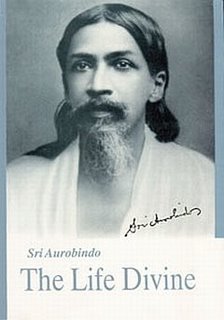 |
Life
An operation of Conscious-Force
What is Conscious-Force or Chit-Shakti at the higher Transcendent ranges projects itself as material energy in inanimate existence, Pranic Energy or Life-Energy in the animate existence and spiritual energy in mystic experience.
‘Life is really a universal operation of Conscious-Force acting subconsciously on and in Matter; it is the operation that creates, maintains, destroys and re-creates forms or bodies and attempts by play of nerve-force, that is to say, by currents of interchange of stimulating energy to awake conscious sensation in those bodies. In this operation there are three stages; the lowest is that in which the vibration is still in the sleep of Matter, entirely subconscious so as to seem wholly mechanical; the middle stage is that in which it becomes capable of a response still submental but on the verge of what we know as consciousness; the highest is that in which life develops conscious mentality in the form of a mentally perceptible sensation which in this transition becomes the basis for the development of sense-mind and intelligence. It is in the middle stage that we catch the idea of Life as distinguished from Matter and Mind, but in reality it is the same in all the stages and always a middle term between Mind and Matter; constituent of the latter and instinct with the former’. (The Life Divine, pg. 200-201).
|
|
Linking Mind and Matter
Sri Aurobindo explains how Life-Energy or Prana links Mind and Matter. It transmits informational sensory inputs as afferent signals from the physical consciousness to the brain through the agency of the nervous system and carries back executing responses through efferent pathways. ‘This means of commerce Life provides in the continual currents of her pulsating nerve-energy which carry force of the form as a sensation to modify Mind and bring back force of Mind as will to modify Matter. It is therefore this nerve-energy which we usually mean when we talk of Life; it is the Prana or Life-Force of the Indian system’. (Ibid, pg.201)
There is something more. In his commentary on the Isha Upanishad, Sri Aurobindo explains how the consciousness that surpasses the brain and works though supra-rational techniques like intuition can also work through subtle channels of Pranic energy to exert its creative touch on matter. This is how Yogis with developed ‘will-power’ can execute miraculous feats like levitation or can suspend breathing for long periods or subsist without food for many days at a stretch. Of course, in the process, yogis employ the technique of gathering the life-energy or Prana ‘into the mind-organ and from there in its simple undifferentiated form support and hold together the physical case’ (Isha Upanishad, pg.253). He comments, ‘Prana, differentiated and working physically, was the basis of all physical activity, so Prana, intermediate and working psycho-physically, is at the basis of all mental activity, and Prana, pure and working psychically is at the basis of all psychical activity’ (Ibid, pg.254)
Life is therefore not a blind force thrown into the manifestation but invested with meaning and purpose, ‘an energizing of conscious being which is a cause and support of the formation of substance and an intermediate source and support of conscious mental apprehension’ (The Life Divine, pg.201). That conscious being is the eternal Purusha, simultaneously universalized and individualized, who in energized form acts through Prakriti or Nature to uphold and sustain the throb of life.
‘This is the whole significance of the omnipresent Life that has manifested and inhabits the material universe.’ (Ibid)
Date of Update:
23-Oct-17
- By Dr. Soumitra Basu
|

